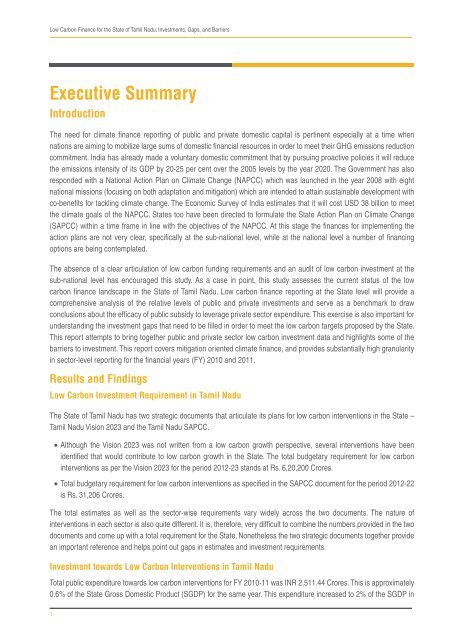Low-Carbon-Finance-for-the-State-of-Tamil-Nadu-Investments-Gaps-and-Barriers - Shakti Foundation
Create successful ePaper yourself
Turn your PDF publications into a flip-book with our unique Google optimized e-Paper software.
<strong>Low</strong> <strong>Carbon</strong> <strong>Finance</strong> <strong>for</strong> <strong>the</strong> <strong>State</strong> <strong>of</strong> <strong>Tamil</strong> <strong>Nadu</strong>: <strong>Investments</strong>, <strong>Gaps</strong>, <strong>and</strong> <strong>Barriers</strong><br />
Executive Summary<br />
Introduction<br />
The need <strong>for</strong> climate finance reporting <strong>of</strong> public <strong>and</strong> private domestic capital is pertinent especially at a time when<br />
nations are aiming to mobilize large sums <strong>of</strong> domestic financial resources in order to meet <strong>the</strong>ir GHG emissions reduction<br />
commitment. India has already made a voluntary domestic commitment that by pursuing proactive policies it will reduce<br />
<strong>the</strong> emissions intensity <strong>of</strong> its GDP by 20-25 per cent over <strong>the</strong> 2005 levels by <strong>the</strong> year 2020. The Government has also<br />
responded with a National Action Plan on Climate Change (NAPCC) which was launched in <strong>the</strong> year 2008 with eight<br />
national missions (focusing on both adaptation <strong>and</strong> mitigation) which are intended to attain sustainable development with<br />
co-benefits <strong>for</strong> tackling climate change. The Economic Survey <strong>of</strong> India estimates that it will cost USD 38 billion to meet<br />
<strong>the</strong> climate goals <strong>of</strong> <strong>the</strong> NAPCC. <strong>State</strong>s too have been directed to <strong>for</strong>mulate <strong>the</strong> <strong>State</strong> Action Plan on Climate Change<br />
(SAPCC) within a time frame in line with <strong>the</strong> objectives <strong>of</strong> <strong>the</strong> NAPCC. At this stage <strong>the</strong> finances <strong>for</strong> implementing <strong>the</strong><br />
action plans are not very clear, specifically at <strong>the</strong> sub-national level, while at <strong>the</strong> national level a number <strong>of</strong> financing<br />
options are being contemplated.<br />
The absence <strong>of</strong> a clear articulation <strong>of</strong> low carbon funding requirements <strong>and</strong> an audit <strong>of</strong> low carbon investment at <strong>the</strong><br />
sub-national level has encouraged this study. As a case in point, this study assesses <strong>the</strong> current status <strong>of</strong> <strong>the</strong> low<br />
carbon finance l<strong>and</strong>scape in <strong>the</strong> <strong>State</strong> <strong>of</strong> <strong>Tamil</strong> <strong>Nadu</strong>. <strong>Low</strong> carbon finance reporting at <strong>the</strong> <strong>State</strong> level will provide a<br />
comprehensive analysis <strong>of</strong> <strong>the</strong> relative levels <strong>of</strong> public <strong>and</strong> private investments <strong>and</strong> serve as a benchmark to draw<br />
conclusions about <strong>the</strong> efficacy <strong>of</strong> public subsidy to leverage private sector expenditure. This exercise is also important <strong>for</strong><br />
underst<strong>and</strong>ing <strong>the</strong> investment gaps that need to be filled in order to meet <strong>the</strong> low carbon targets proposed by <strong>the</strong> <strong>State</strong>.<br />
This report attempts to bring toge<strong>the</strong>r public <strong>and</strong> private sector low carbon investment data <strong>and</strong> highlights some <strong>of</strong> <strong>the</strong><br />
barriers to investment. This report covers mitigation oriented climate finance, <strong>and</strong> provides substantially high granularity<br />
in sector-level reporting <strong>for</strong> <strong>the</strong> financial years (FY) 2010 <strong>and</strong> 2011.<br />
Results <strong>and</strong> Findings<br />
<strong>Low</strong> <strong>Carbon</strong> Investment Requirement in <strong>Tamil</strong> <strong>Nadu</strong><br />
The <strong>State</strong> <strong>of</strong> <strong>Tamil</strong> <strong>Nadu</strong> has two strategic documents that articulate its plans <strong>for</strong> low carbon interventions in <strong>the</strong> <strong>State</strong> –<br />
<strong>Tamil</strong> <strong>Nadu</strong> Vision 2023 <strong>and</strong> <strong>the</strong> <strong>Tamil</strong> <strong>Nadu</strong> SAPCC.<br />
• Although <strong>the</strong> Vision 2023 was not written from a low carbon growth perspective, several interventions have been<br />
identified that would contribute to low carbon growth in <strong>the</strong> <strong>State</strong>. The total budgetary requirement <strong>for</strong> low carbon<br />
interventions as per <strong>the</strong> Vision 2023 <strong>for</strong> <strong>the</strong> period 2012-23 st<strong>and</strong>s at Rs. 6,20,200 Crores.<br />
• Total budgetary requirement <strong>for</strong> low carbon interventions as specified in <strong>the</strong> SAPCC document <strong>for</strong> <strong>the</strong> period 2012-22<br />
is Rs. 31,206 Crores.<br />
The total estimates as well as <strong>the</strong> sector-wise requirements vary widely across <strong>the</strong> two documents. The nature <strong>of</strong><br />
interventions in each sector is also quite different. It is, <strong>the</strong>re<strong>for</strong>e, very difficult to combine <strong>the</strong> numbers provided in <strong>the</strong> two<br />
documents <strong>and</strong> come up with a total requirement <strong>for</strong> <strong>the</strong> <strong>State</strong>. None<strong>the</strong>less <strong>the</strong> two strategic documents toge<strong>the</strong>r provide<br />
an important reference <strong>and</strong> helps point out gaps in estimates <strong>and</strong> investment requirements.<br />
Investment towards <strong>Low</strong> <strong>Carbon</strong> Interventions in <strong>Tamil</strong> <strong>Nadu</strong><br />
Total public expenditure towards low carbon interventions <strong>for</strong> FY 2010-11 was INR 2,511.44 Crores. This is approximately<br />
0.6% <strong>of</strong> <strong>the</strong> <strong>State</strong> Gross Domestic Product (SGDP) <strong>for</strong> <strong>the</strong> same year. This expenditure increased to 2% <strong>of</strong> <strong>the</strong> SGDP in<br />
1

















